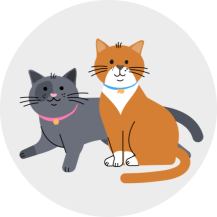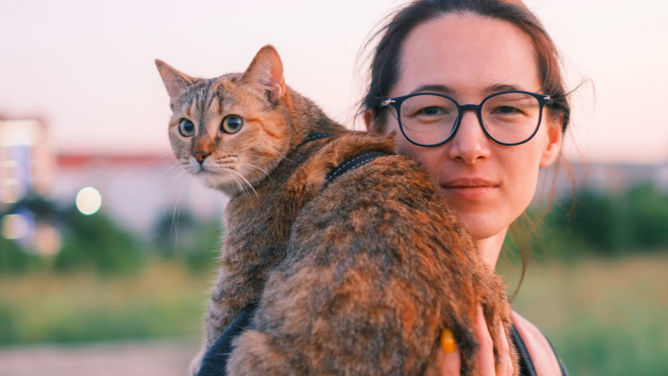The term “no-kill” has sparked controversy in recent years. Some animal advocates claim it demonizes open-admission shelters who take in high-risk animals, like neonates, seniors, and sick or injured cats. For shelters like this, we understand that a 90% or higher live-release rate of animals isn’t always possible. A live release rate is the percentage of animals who leave a shelter with a “live outcome,” like getting adopted, returning to their family, being returned to their outdoor home or getting transferred. We also don’t designate individual shelters as “no-kill” or “kill.”
In some cases, euthanasia is the most humane outcome for a cat. A nation where no cats are killed isn’t the same as a nation where no cats are euthanized. As anyone who has put a beloved pet down knows, it can be the most compassionate choice for a suffering animal.
However, we still believe “no-kill nation” is a helpful vision for a world where no animals lose their lives for preventable reasons. We hope to end the use of euthanasia as a means of population control in shelters.
The right solution is different for each cat! Some cats are social and love people. The right solution for them may be a loving home. Some cats are shy but are great mousers. The right solution for these cats may be a barn. Some cats have lived outside their whole lives and are happiest that way. The right solution for them may be to live in a community of cats outside.
So, how do we help each cat live their best life? We raise awareness and we equip shelters with life-saving practices.

There are more cats in our country than there are people who want to care for cats. An estimated 30-40 million cats are “free-roaming.”
By surgically removing a cat’s ability to reproduce, we decrease the number of unwanted kittens born. This, in turn, decreases the population of free-roaming cats. Some studies have found as much as a 78% decrease in community cat populations that were spayed and neutered! In a no-kill nation, fewer cats born means more cats get a chance at life, love and a home.
But spay and neuter efforts aren’t just about reducing the cat population. These surgeries also give cats longer lives and make them better pets and neighbors — making them less likely to be euthanized. When a female cat gets spayed, her risk for developing reproductive cancers and pyometra (an infection of the uterus) plummets. She also stops going into heat, which means she’s less likely to yowl or escape. (All the cat people said hooray!) When a male cat gets neutered, his risk of developing testicular cancer diminishes. A neutered cat sprays less, and he’s not as aggressive. (Another win for the humans he lives with!) We’re on a mission to educate the public about the life-saving benefits of spay/neuter for all cats.
Spay/neuter isn’t the only veterinary care a cat needs. Far too many cats die of preventable causes that result from not being vaccinated or microchipped. Preventative veterinary care is a critical component in a no-kill nation. For example, the FVRCP vaccine prevents panleukopenia in cats, a potentially fatal disease. Microchips save lives, too. Imagine someone’s cat gets lost outside and someone else takes that cat to a shelter. If that cat doesn’t have a microchip, it’s at risk for being turned away, moved to a shelter farther away or even euthanized.
All cats — whether they live outside or inside and have a human caregiver or not — need veterinary care. There are options for cats that aren’t socialized or easy to trap, too: Vet outreach programs like One Health treat the animal wherever they are.

“Community cats” live outdoors, and they aren’t someone’s pet. They can be safe and happy outside — as long as they’re spayed/neutered and have food, water and shelter. As a general rule, community cats should only be taken to a shelter or clinic if they are not altered. But too often these cats are removed from their outdoor homes and taken to shelters. At best, they’re turned away; at worst, they’re euthanized. Sadly, community cats make up the largest percentage of cats euthanized in shelters.
We advocate for Trap, Neuter, and Return as the safest and most humane method of controlling the population of community cats.
In order to save cats’ lives, shelters rely on people who adopt. Not only does adoption give a cat a loving home for life, but it also frees up shelter space for more cats who need help. A no-kill nation needs humans who adopt from their local shelter. (Adopting a friendly free-roaming cat counts, too!) It especially requires humans who are willing to adopt cats who are often overlooked and are most at risk, such as:

When we work together, we can create a no-kill nation, where every cat gets the love and care they deserve.
Sources:
Opinion: We Are Here to Care for the Animals “No-kill” Shelters Turn Away, The Denver Post
The “No-Kill” Controversy, Lifeline Animal Project
“No Kill” label divides shelters, diminishes impact, Michigan Humane
Shelter Intake and Surrender, ASPCA
Pets by the Numbers, Humane World for Animals
Lifesaving by the Numbers: Animal Welfare Statistics, Best Friends
2023 Annual Analysis, Shelter Animals Count